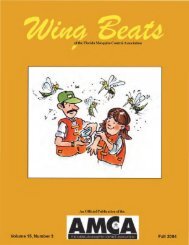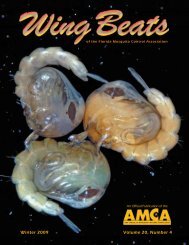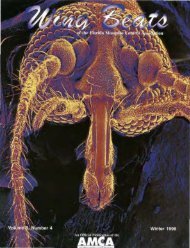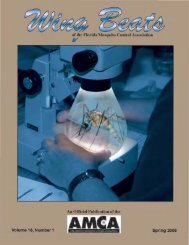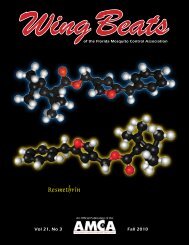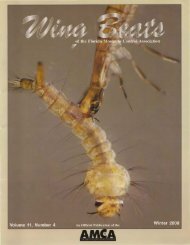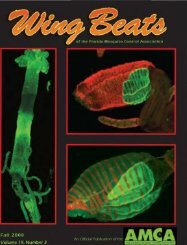Volume 23 Number 1 - Wing Beats - Wing Beats - Florida Mosquito ...
Volume 23 Number 1 - Wing Beats - Wing Beats - Florida Mosquito ...
Volume 23 Number 1 - Wing Beats - Wing Beats - Florida Mosquito ...
You also want an ePaper? Increase the reach of your titles
YUMPU automatically turns print PDFs into web optimized ePapers that Google loves.
40<br />
Figure 3: Our design standard of a cobble line low flow channel for detention/retention basins.<br />
midges while minimizing the burrowing<br />
of rodents.<br />
In addition, our program developed<br />
a wetland model design<br />
using a meandering low flow<br />
channel in which storm water<br />
runoff from development flows<br />
through the wetland. Ponds can<br />
be constructed and connected<br />
to the low flow channel with water<br />
flowing into and exiting the pond<br />
through the meandering channel<br />
system. Forebays are constructed<br />
below the outfall pipes which<br />
capture sediment, debris and<br />
urban litter from development<br />
discharges from entering the<br />
wetlands. Included in our wetland<br />
design are native plants<br />
associated with our high desert<br />
environment planted on the<br />
upland slopes. Our experience<br />
in wetlands is if an unmanaged<br />
monoculture, such as perennial<br />
pepper weed (Lepidium latifolium)<br />
and/or cattails (Typha spp)<br />
is allowed to exist, it out competes<br />
a desirable and diversity of<br />
plant species creating an environment<br />
conducive to mosquito<br />
development.<br />
The Cities of Reno, Sparks and<br />
Washoe County Community Development<br />
require rockery walls<br />
and mechanically armoring<br />
slopes to stabilize hillsides as development<br />
moves off the valley<br />
floor. The Vector-Borne Diseases<br />
Program has standards for rockery<br />
walls, by filling the voids with<br />
smaller rock in the rockery wall<br />
for the entire height. For slope<br />
stabilization of hill sides, mixed<br />
aggregate rock is placed in the<br />
voids to a depth of 3 inches.<br />
With plague endemic in Washoe<br />
County, these design standards<br />
also discourages void formation<br />
for rodent habitat.<br />
The VBDP began a collaborative<br />
effort with Washoe County Com-<br />
Spring 2012 <strong>Wing</strong> <strong>Beats</strong><br />
munity Development and Jensen<br />
Precast to design new as well as<br />
retrofitting existing catch basins/<br />
drop inlets (DIs) that improves<br />
water quality and at the same<br />
time prevents the colonization by<br />
mosquitoes. Our first design was<br />
developed in 2008 with Jensen<br />
Precast modifying the basin by<br />
placing 1 inch diameter weep<br />
holes on the side walls and end<br />
walls of the DIs. As water enters<br />
the basin from the curb it will<br />
weep out through the one inch<br />
diameter holes in the basin, eliminating<br />
any standing water in the<br />
sump. Unfortunately, our design<br />
was not approved by Reno and<br />
Sparks because the weep hole<br />
catch basin was considered an<br />
injection well by definition of the<br />
Nevada Department of Environmental<br />
Protection (NDEP).<br />
In 2009 work began with Washoe<br />
County and Xeripave which<br />
manufactures pervious pavers to



